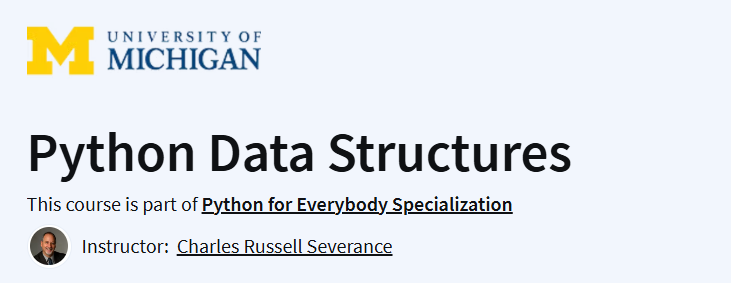What you will learn in Python Data Structures Course
Understand the fundamental building blocks of programming using Python.
Write simple programs involving variables, expressions, and functions.
Manipulate text using strings and design functions effectively.
-
- Store and manipulate data using Python dictionaries and tuples.
- Perform multi-step tasks such as sorting and looping using Python’s built-in data structures.
Program Overview
Strings
⏱️ 3 hours
- Manipulate and process text data using Python string methods.
Installing and Using Python
⏱️ 2 hours
- Set up Python on your system and understand the development environment.
Files
⏱️3 hours
- Read from and write to files, handling file data efficiently.
Lists
⏱️3 hours
Utilize lists for storing sequences of data and perform operations like slicing and sorting.
Dictionaries
⏱️3 hours
Implement key-value pairs using dictionaries for efficient data retrieval.
Tuples
⏱️3 hours
Understand tuples and their immutability, and use them for fixed collections of items.
Capstone Assignment
⏱️1 hours
- Apply the learned concepts in a comprehensive assignment to consolidate your understanding.
Get certificate
Job Outlook
- Proficiency in Python data structures is essential for roles in data analysis, software development, and automation.
- Skills acquired in this course are foundational for careers in data science, machine learning, and backend development.
- Understanding file handling and data manipulation prepares learners for real-world programming tasks.
Specification: Python Data Structures
|
FAQs
- The course features 7 modules, covering key topics like strings, files, lists, dictionaries, and tuples.
- Estimated effort is about 2 weeks, assuming a pace of 10 hours per week (20 hours total).
- Module time estimates include around 3 hours for Strings, 2 hours for Python setup, 3 hours for Files, 3 hours for Lists, and similar durations for Dictionaries and Tuples.
- Self-paced format allows learners to accelerate or slow down based on their availability.
- Extra time may be needed if you choose to install Python locally versus using the in-browser Python Code Playground.
- The course is beginner-friendly—part of a specialization tailored for new coders, with no prior experience required.
- Builds directly upon fundamental procedural programming concepts.
- You’ll dive into Python’s core built-in structures—lists, dictionaries, tuples, and strings—after getting comfortable with basics.
- Ideal for students familiar with basic math and logic, but prior coding knowledge is not necessary.
- Practices computational thinking and problem decomposition through hands-on examples.
- Courses include video lectures, readings, and practical assignments using both built-in tools and application items.
- Hands-on elements include using the Python Code Playground for writing and testing code without needing local setup.
- You’ll work with real tasks—like reading from files, manipulating lists, handling dictionaries, and writing tuple-based loops.
- Expect both quizzes and coding assignments that reinforce learning via practice.
- Community-contributed GitHub repos demonstrate assignment structures and can help you compare solutions.
Strengths:
- Extremely well-rated—4.9 with nearly 97,000 reviews, and 98% of learners report high satisfaction.
- Clear, modular structure based on the popular Python for Everybody textbook, great for structured learning.
- Certified by the University of Michigan, with shareable credentials upon completion.
- Powered by a flexible and accessible learning platform.
Limitations:
- Focuses solely on basic, built-in data structures; more advanced topics like linked lists or trees are not included.
- Minimal discussion interactivity—progress relies on self-driven practice and discipline.
- Next step in the specialization: “Python for Everybody Part II”, which expands into regular expressions, web data, and databases.
- Explore more advanced data structures and algorithms with courses like UC San Diego’s Data Structures and Algorithms Specialization.
- Practice through guided projects—e.g. Coursera’s Python for Beginners: Data Structures (~2 hours project).
- Supplement with external platforms like MIT’s Intro to Computer Science, or work on personal coding projects like building text parsers or simple data processing scripts.
- Share completed projects and certificates on GitHub or LinkedIn to showcase your growing skills.





